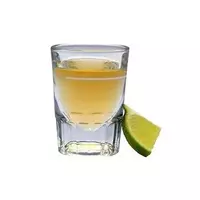Tequila

Enjoyed at both fun holidays and raucous parties, this gorgeous drink has come to us from faraway Mexico. Slowly, but confidently, in small portions, tequila is drunk quite gently, and therefore it is very likely that it is possible to go through too much. By the way, the calorie content of tequila is 208 kcal per 100 grams of Mexican strong drink.
Traditionally, tequila is consumed in a certain way, namely by licking a small amount of salt from the back of the palm of your hand, drinking a drink, and then snacking it on a slice of lime or lemon. Interestingly, in some countries, salt is replaced by cinnamon, and sour citrus fruits by a more refined orange. Perhaps the taste of tequila only benefits from this, but the choice still remains with the lover of this drink.
Sometimes there is an opinion among foreigners (which, by the way, is recognized as erroneous) that there is a "worm" in the bottles of certain types of this drink, which increases the value of alcohol among foodies. This refers to the mezcali tequila originally from the state of Oaxaca, which is sold con gusano ("with worm") - which became a marketing ploy in the forties of the 20th century. In fact, everything is simple: this is not a worm, but a moth caterpillar that is found on agave plants. If there is an insect in the bottle that got there during the production process, then tequila is not of high quality, since the use of insects in this drink is prohibited by the standard.
Types of tequila
Traditionally, about seven types of tequila are distinguished, which depend on the aging of a given alcoholic drink. Silver or white tequila is called Silver, Plata or Blanca and can be aged for no more than 2 months. The tinted or flavored young drink is called Joven. Gold, colored for resemblance to aged tequila - Gold.
Then there are more expensive elite types of tequila: Reposado, which means "rested, " can be aged for about a year, and Anejo tequila takes 1 to 3 years to mature. All drinks that last more than three years are called Extra anejo.
In addition, there is a special classification for the percentage of agave juice, based on which all tequila is divided into 2 groups: tequila 100% Agave and tequila mixta, which includes drinks from mixed sugars.
Tequila composition
In tequila, there is nothing at all from cacti, as is often believed, and this strong drink is made from blue agave - a plant of the desert lily family, which resembles aloe. Therefore, based on the manufacturing technology, the composition of tequila is as follows: juice obtained from the core of blue agave, distilled water, yeast and corn syrup or cane sugar.
tequila 208 kCal
Energy value of tequila (Ratio of proteins, fats, carbohydrates - ju):
Proteins: 0 g (~ 0 kCal)
Fats: 0 g (~ 0 kCal)
Carbohydrates: 34.83 g (~ 139 kCal)
Energy ratio (bj | y): 0% | 0% | 67%
 Español
Español Français
Français Português
Português Русский
Русский 简体中文
简体中文 繁體中文
繁體中文 日本語
日本語 한국어
한국어 العربية
العربية Türkçe
Türkçe Қазақ
Қазақ Deutsch
Deutsch Italiano
Italiano Українська
Українська
